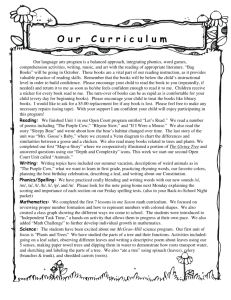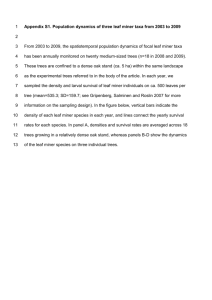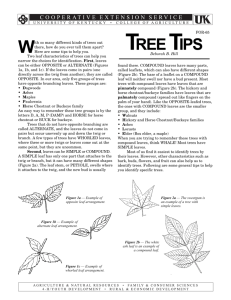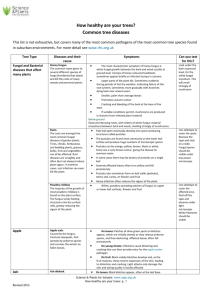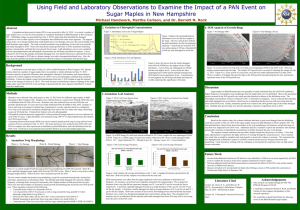Forestry Review Packet - Applied Ecology
advertisement
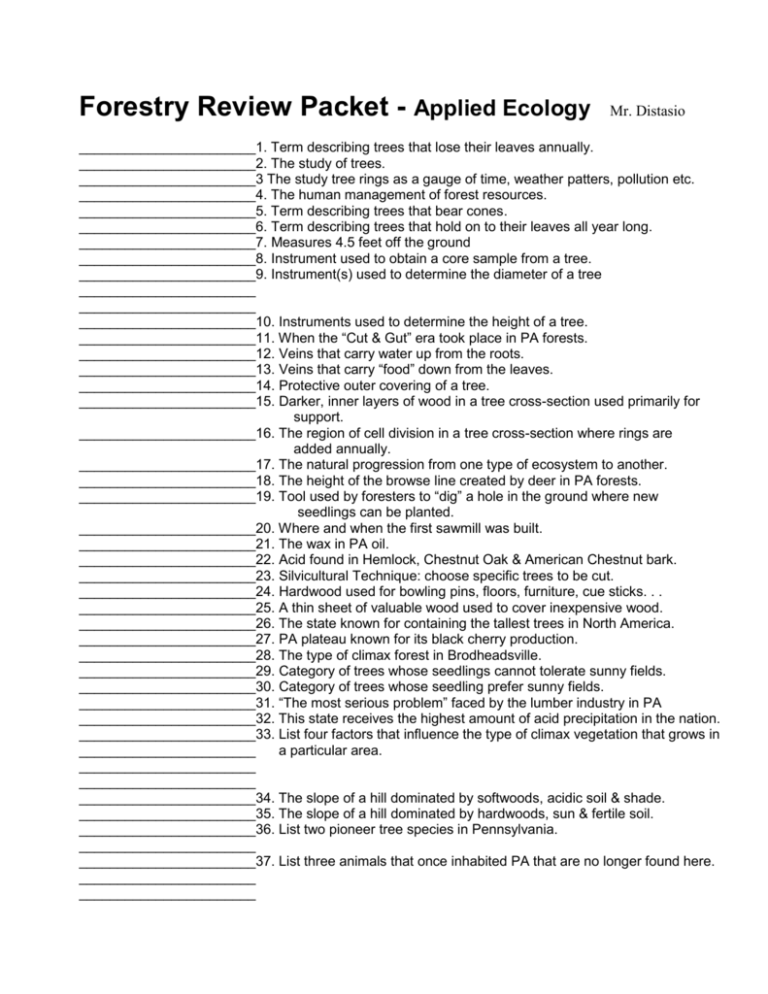
Forestry Review Packet - Applied Ecology Mr. Distasio _______________________1. Term describing trees that lose their leaves annually. _______________________2. The study of trees. _______________________3 The study tree rings as a gauge of time, weather patters, pollution etc. _______________________4. The human management of forest resources. _______________________5. Term describing trees that bear cones. _______________________6. Term describing trees that hold on to their leaves all year long. _______________________7. Measures 4.5 feet off the ground _______________________8. Instrument used to obtain a core sample from a tree. _______________________9. Instrument(s) used to determine the diameter of a tree _______________________ _______________________ _______________________10. Instruments used to determine the height of a tree. _______________________11. When the “Cut & Gut” era took place in PA forests. _______________________12. Veins that carry water up from the roots. _______________________13. Veins that carry “food” down from the leaves. _______________________14. Protective outer covering of a tree. _______________________15. Darker, inner layers of wood in a tree cross-section used primarily for support. _______________________16. The region of cell division in a tree cross-section where rings are added annually. _______________________17. The natural progression from one type of ecosystem to another. _______________________18. The height of the browse line created by deer in PA forests. _______________________19. Tool used by foresters to “dig” a hole in the ground where new seedlings can be planted. _______________________20. Where and when the first sawmill was built. _______________________21. The wax in PA oil. _______________________22. Acid found in Hemlock, Chestnut Oak & American Chestnut bark. _______________________23. Silvicultural Technique: choose specific trees to be cut. _______________________24. Hardwood used for bowling pins, floors, furniture, cue sticks. . . _______________________25. A thin sheet of valuable wood used to cover inexpensive wood. _______________________26. The state known for containing the tallest trees in North America. _______________________27. PA plateau known for its black cherry production. _______________________28. The type of climax forest in Brodheadsville. _______________________29. Category of trees whose seedlings cannot tolerate sunny fields. _______________________30. Category of trees whose seedling prefer sunny fields. _______________________31. “The most serious problem” faced by the lumber industry in PA _______________________32. This state receives the highest amount of acid precipitation in the nation. _______________________33. List four factors that influence the type of climax vegetation that grows in _______________________ a particular area. _______________________ _______________________ _______________________34. The slope of a hill dominated by softwoods, acidic soil & shade. _______________________35. The slope of a hill dominated by hardwoods, sun & fertile soil. _______________________36. List two pioneer tree species in Pennsylvania. _______________________ _______________________37. List three animals that once inhabited PA that are no longer found here. _______________________ _______________________ _______________________38. The only five-needled pine in PA _______________________39. This classification of wood is usually ground up to make paper. _______________________40. Measures 12”X12”X1” _______________________41. Baseball bats, tennis racquets: compound, opposite leaves _______________________42. Chemical used by the U.S. Forest Service to eradicate ferns. _______________________43. Silvicultural technique that involves the cutting of nearly ever tree. _______________________44. Venation pattern: veins branch from a central midrib. _______________________45. Venation pattern: veins branch from a point at the leaf base. _______________________46. Venation pattern: Veins run side-by-side _______________________47. Leaf composition: blade all in one piece _______________________48. Leaf composition: Blade divided into leaflets _______________________49. Leaf Arrangement: One leaf per node _______________________50 Leaf Arrangement: two leaves per node _______________________51. Leaf margin: deep sinuses _______________________52. Leaf margin: regular notches, grooves or serrations. _______________________53. Leaf margin: smooth, no notches or teeth of any kind. _______________________54. Piece of equipment used to cut & bundle trees quickly. _______________________55. Piece of equipment used to drag cut logs to a landing deck. _______________________56. “Oven” used to dry fresh lumber to desired moisture content. _______________________57. Type of succession that begins with bare rock. _______________________58. Type of succession beginning with soil. _______________________59. The killing of a tree by removing a ring of bark around the tree. _______________________60. List three shade intolerant tree species. _______________________ _______________________ _______________________61. From largest to smallest, list the four crown classes in a typical forest. _______________________ _______________________ _______________________ _______________________62. Pores in the bark of trees used for gas exchange. _______________________63. The bud at the end of a twig responsible for primary growth. _______________________64. The buds along the side of twig responsible for secondary growth. _______________________65. The scar on a twig left behind by last year’s bud _______________________66. The very center of a leaf cross-section. _______________________67. The central vein running down the middle of a pinnate leaf. _______________________68. The ”fruits” of hardwood trees. _______________________69. Silvicultural technique that involves leaving mature trees for protection and seed production. _______________________70. The only insect in the world to conduct an annual mass migration. You should also know the information regarding wood use, and the descriptions of the individual tree species.
